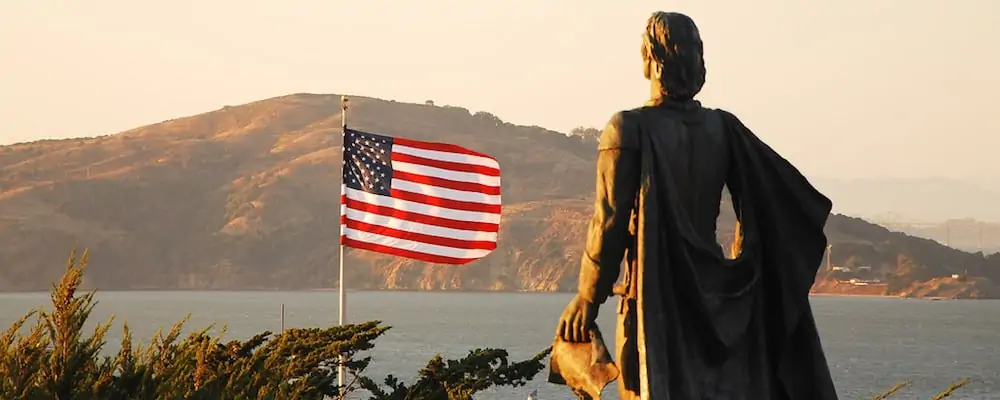Blog
This is the second of two lessons that teach research and comprehension skills around the topic of the Christopher Columbus. Also, don’t forget to have students cite their sources in MLA format, APA format, or the style of your choice.
Photo Source: “Christopher Columbus” by May Wong. Licensed under CC BY 2.0. Original image was cropped.
Overview
You will learn:
- How to analyze a series of events to determine cause and effect
- How to analyze common themes across multiple historical documents
Defining Cause and Effect
History does not happen in a vacuum, meaning that historical events are influenced by previous events, and in turn, impact future events.
The cause is an event or action that triggers a future action, or reaction, referred to as an effect. An effect may happen immediately following the cause, or it may occur days, weeks, months, or even years later.
Importance of Cause-Effect Relationships
Learning how to identify cause and effect relationships helps to explain how or why certain historical events occurred over time. It also helps to explain in what ways the events affected, or were affected by, the greater historical context.
Historical context is the combination of factors that create the “big picture” of a point in time, including the setting, major events, and social, cultural, political and economic factors that influenced the way contemporary people thought and acted.
Examples of Cause-Effect Relationships in Economics
Listen to the clip below:
Cause: High demand for silk in Europe
Effect: Europeans traveled to Asia to find sources of the fabric
Cause: Europeans traveled to Asia to find sources of the fabric
Effect: Trade routes and trade partnerships were formed between Europe and Asia
Is It a Cause or Just an Event?
Cause-effect relationships happen just as they’re described; the cause event always precedes, or happens before, the effect event. That does not mean, however, that all preceding events are causes.
Sometimes an event is just an event; it may not have any significant effect.
View the example below. Read each sentence and determine which events caused another event, and which ones are simply preceding. Hover your mouse over the green and blue icons below to view the correct responses.
Perspective
Perspective is synonymous with point of view. It takes into account the specific attitudes you may have when approaching or looking at something, or the unique vantage point that you may hold.
There are many things that shape perspective including age, personal experiences, political orientation, religious beliefs, and cultural and social factors.
Historical Perspective
Perspective not only plays a role in your daily life, but in social studies as well. Historical perspective refers to the specific lens through which we view past events. Your own personal beliefs and experiences will influence the specific perspective you have of an event.
The same goes for historians and economists. No two perspectives will be identical, and in many cases, there are multiple and diverse perspectives of the same event.
Analyzing Perspective
Questions to ask:
- Who created the primary source? What important information do I know about this individual or group of individuals?
- When was the source created?
- Why was the source created?
Analyzing Perspective – Who?
The first question you should ask is who created the primary source? What important information do I know about the individual or group of individuals? Identifying the author or creator of a source highlights important information about their perspective.
For example, after his arrival in the New World, Christopher Columbus labeled the Native Americans he met as “Indians.” Columbus believed he was sailing to the Indies, not to the Americas.
Analyzing Perspective – When?
Listen to the clip below:
Questions to ask:
- When was the source created?
- Specific point in time influences perspective
- Perspectives vary at time of the event
- Perspectives vary between time of the event and later in history
Analyzing Perspective – Why?
Questions to ask:
- Why did the author create the source?
- What is the author’s intent or what are they trying to convey to the reader?
- Applies to both primary and secondary sources.
Example of Primary Source Perspective
Read the accounts of the interactions with Native American from the perspectives of
Christopher Columbus and Bartolome de las Casas.
While reading, ask yourself the three questions for analyzing perspective. How do the unique perspectives of Columbus and de las Casas impact their accounts of similar events?
Example of Secondary Source Perspective
Read the example about varied perspectives with regards to Christopher Columbus. The example is located in the first gray box at the top of the page.
Note how each historian’s perspective is influenced by their beliefs about and interpretation of Christopher Columbus.
The first historian paints Columbus’s voyage in a negative light, while the second recounts a much more optimistic version of the same story.
Conclusion
In this lesson you learned:
- the role that cause-effect relationships play in social studies and especially economics
- the difference between causal events and preceding events
- the factors that influence perspective
- how to analyze the varied perspectives about the same event, person, or period in time



